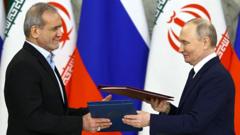In a televised address, Iran’s Supreme Leader Ayatollah Ali Khamenei has rejected President Trump’s ultimatum for unconditional surrender, asserting that any U.S. military intervention would result in “irreparable damage.” The waves of conflict escalate as Israel intensifies its airstrikes on Iranian nuclear facilities, raising fears of a broader regional confrontation.
Tensions Escalate as Iran's Supreme Leader Vows Resistance to U.S. Threats

Tensions Escalate as Iran's Supreme Leader Vows Resistance to U.S. Threats
Iran's Ayatollah Ali Khamenei dismisses calls for surrender amidst Israel's military strikes, warning of devastating retaliation against U.S. involvement.
In a volatile day of escalating geopolitical tensions, Iran's Supreme Leader, Ayatollah Ali Khamenei, firmly rejected U.S. President Trump's recent threats, robustly defending Iran's sovereignty during a televised address. Khamenei’s remarks came as Israel intensified its bombing campaign on Iranian nuclear sites. He stated, “The Iranian nation cannot be surrendered,” warning that any U.S. military involvement would lead to catastrophic consequences.
This confrontation marks the sixth day of intense fighting, with Israeli forces launching over 50 warplanes in strikes targeting key nuclear facilities in Iran's capital. The Israeli military reported successful hits on several weapons production sites, including a centrifuge plant, crucial to Iran's nuclear ambitions. In retaliation, Iran unleashed around 30 ballistic missiles and drone strikes towards Israel, most of which were intercepted, though the conflict's persistent violence brings forth a sense of urgency and apprehension in the region.
The U.S., weighing its options, appears increasingly poised for potential direct intervention alongside Israel, a significant shift from its historically cautious stance on Middle Eastern entanglements. Fears of a broader conflict loom large, as Iranian officials have warned of severe repercussions for any American bases should the U.S. choose to escalate its involvement further. Khamenei's persistent defiance echoes the broader Iranian ethos of resisting external pressures, amidst growing concerns over national security and the implications of military action.
Meanwhile, the humanitarian impact is becoming palpable, with casualties rising on both sides. Reports from Iran highlight hundreds of civilians affected, underscoring the complex interplay of military strategy and the tragic human cost of escalating hostilities. Observers are now turned towards how the U.S. will navigate its response in light of these developments and whether diplomatic channels remain viable in this increasingly fraught environment.
As regional dynamics shift, we will continue to monitor the evolving situation closely, reflecting on the potential ramifications for international relations and the precarious state of peace in the Middle East.
This confrontation marks the sixth day of intense fighting, with Israeli forces launching over 50 warplanes in strikes targeting key nuclear facilities in Iran's capital. The Israeli military reported successful hits on several weapons production sites, including a centrifuge plant, crucial to Iran's nuclear ambitions. In retaliation, Iran unleashed around 30 ballistic missiles and drone strikes towards Israel, most of which were intercepted, though the conflict's persistent violence brings forth a sense of urgency and apprehension in the region.
The U.S., weighing its options, appears increasingly poised for potential direct intervention alongside Israel, a significant shift from its historically cautious stance on Middle Eastern entanglements. Fears of a broader conflict loom large, as Iranian officials have warned of severe repercussions for any American bases should the U.S. choose to escalate its involvement further. Khamenei's persistent defiance echoes the broader Iranian ethos of resisting external pressures, amidst growing concerns over national security and the implications of military action.
Meanwhile, the humanitarian impact is becoming palpable, with casualties rising on both sides. Reports from Iran highlight hundreds of civilians affected, underscoring the complex interplay of military strategy and the tragic human cost of escalating hostilities. Observers are now turned towards how the U.S. will navigate its response in light of these developments and whether diplomatic channels remain viable in this increasingly fraught environment.
As regional dynamics shift, we will continue to monitor the evolving situation closely, reflecting on the potential ramifications for international relations and the precarious state of peace in the Middle East.





















